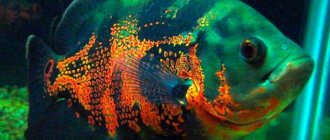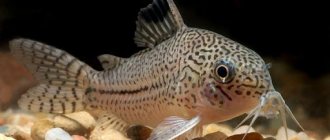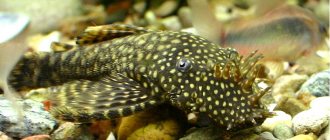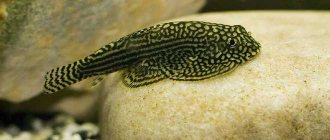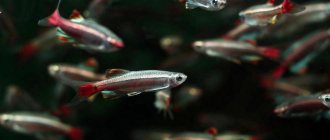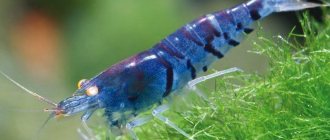Catfish is an amazing fish, which, depending on the species, can weigh up to 200 kilograms, and some aquarium specimens do not exceed two centimeters in length. The uniqueness of pets lies in their resistance to external conditions, which allows them to feel comfortable in the wild, both in swamps and fast-water rivers. When placed in an aquarium, catfish become real orderlies, eating all the garbage and leftover food from other fish. Let's look at the features of keeping these pets at home and figure out what to feed aquarium catfish.
What and how much to feed catfish in an aquarium (from fry to adults)?
- Feeding different types of catfish
- How to feed catfish fry?
- How often to feed catfish?
- Errors in feeding catfish
Domestic catfish are considered aquarium orderlies. They are often purchased for the purpose of absorbing debris and waste left by other fish. But this is precisely the main mistake that beginner aquarists make. Not everyone knows what to feed catfish, believing that these unique fish will be content with low-quality food, or, simply put, carrion. This deep misconception leads to the fact that aquarium catfish acquire diseases of the digestive system, which shortens their life expectancy.
It is advisable to feed domestic catfish with ready-made food available in pet stores. Typically the diet of these fish includes:
- tubifex;
- bloodworm;
- coretra;
- Cyclops;
- gammarus.
Traditionally, food is offered in dry or frozen form. Live food is not recommended for catfish, since there is a high probability of infecting fish with helminth eggs. Additionally, fish can be fed with shrimp meat, boiled yolk, beef offal, squid and pieces of fish. You should know that domestic catfish are not averse to feeding on live fish, so small fish should not coexist with predatory catfish. Fish whose size is larger than the mouth of a catfish can safely swim with it in the same aquarium.
Productivity indicators
When African catfish are 6 months old, they are ready to be caught for further sale. Already during this period, the marketable weight of fish is about 1 kilogram. The productivity of clariid catfish is related to the quantity and quality of food.
African catfish is considered a fish that strictly gains weight according to plan, due to which a businessman can independently calculate how much weight the fish will gain when fed a certain amount of food. Accordingly, it is also possible to calculate the percentage of expected profit.
Feeding different types of catfish
Before you understand what to feed catfish in an aquarium, you need to understand that there are certain recommendations for each species. If the aquarium is inhabited exclusively by catfish, then there will be no problems with feeding them. It is enough to feed the fish with ready-made compounds offered in pet stores. Food for catfish is offered in the form of compressed tablets that slowly soak in water as they sink to the ground.
What to feed the sticky catfish, which has special dietary preferences? This species happily absorbs plaque from the aquarium, which makes caring for these catfish especially easy. But the fish won’t be able to feed themselves on the fly alone. This species is very shy, and it is best to feed the clings, also known as ancistrus, in the evening. How and what to feed Ancistrus catfish largely depends on their lifestyle. In the aquarium, these fish are in constant motion, which distinguishes them from most species of catfish.
With irregular feeding, ancistrus become carnivorous, so these fish cannot be kept with other species without additional feeding. Both dry and live food are suitable for stickies. To compensate for vitamin deficiency, live greens should be introduced into your pet’s diet. Lettuce, cabbage, dandelion or nettle leaves are good for this purpose. Greens should be doused with boiling water before serving. In the absence of additional greenery, sticky catfish can eat the vegetation in the aquarium.
Video about what to feed catfish in an aquarium
Ancistrus' favorite treats are bloodworms and tubifex. It is important that live food sinks to the bottom, where a carnivorous pet can find it.
Owners of speckled corydoros often wonder: what to feed speckled catfish? This species of fish is significantly different from ordinary aquarium catfish. They happily eat leftover food from other fish and also clean the aquarium well of sediment. Speckled catfish usually do not pester other fish, which makes it possible for them to live side by side with other peaceful inhabitants of the aquarium. Speckled Corydoros are voracious, and if food is not rationed, they can die from overeating. Many breeders note that they do not know how much to eat, so fish of this breed should be fed exclusively in portions. If other fish live with them in the aquarium, then there is a high probability that the speckled catfish will be saturated with what they get from their neighbors.
Tarakatum catfish can be fed with regular fish food, occasionally pampering it with meat. This representative of domestic catfish can compete for food with other neighbors in the aquarium. Often he literally jumps up for food that ends up above the ground.
Redtail catfish can be fed with saltwater fish fillets. This species is easy to train and can even take food directly from your hands. Red-tailed catfish happily eat chicken offal and raw capelin.
Where to buy fry for breeding?
After setting up the farm, the entrepreneur must start searching for planting material. Fortunately, farming African catfish in Russia is more widespread than a business such as crab farming, and therefore there should not be any difficulties in purchasing fry. A simple study of advertisements on trade portals allows you to find contacts of at least a dozen nurseries in a few minutes:
Catfish fry suppliers
| Name | City |
| LLC "Yantarny Som" | Kaliningrad |
| LLC "Fish Farm" | Astrakhan |
| Dobrovsky fish hatchery | Lipetsk |
| LLC "Marble Catfish" | Staraya Russa |
| LLC Ecofarm "Rybovod" | Cherepovets |
| LLC NPO "Ocean" | Voskresensk |
| Russian Style LLC | Chelyabinsk |
| LLC Agro | Lipetsk |
| IP Zubarev | Barnaul |
| Impulse LLC | Rostov-on-Don |
For breeding and rearing of African catfish, fry are usually selected at the age of three weeks and older: they can more easily withstand transportation and quickly get used to a new place. They are delivered in special pools or tank trucks equipped with autonomous aerators or oxygen cylinders.
Conditions for keeping catfish
Although one of the advantages of breeding clarium catfish at home is the unpretentiousness of the fish and its tolerance to different environmental conditions, to achieve maximum productivity it is necessary to follow the recommendations of specialists and maintain the most important parameters at an optimal level. So:
- Catfish do not experience any discomfort when the acidity of the water fluctuates within pH 6.0–8.5, but a pH value of 7.0–7.8 is considered comfortable for it;
- The water may be quite cloudy. In this case, its transparency is not as important as when breeding sturgeon or sterlet at home;
- The permissible stocking density of adult fish is in the range of 200–800 kg/m³. When filling 260–450 kg/m³, catfish gain weight the fastest;
- Young and adult catfish prefer to feed in twilight, with illumination of no more than 30–40 lux. Daylight hours are about 12–16 hours;
- The fish is tolerant of a lack of air, and therefore, when breeding clariid catfish in a RAS, aeration is often not needed. But at a concentration of 5–6 mg/l it is more active;
- The thermal regime that is comfortable for catfish is a gradual increase in water temperature from 24°C to 30°C during the day and a decrease to the original level at night.
Any water except chlorinated water is suitable for filling swimming pools. But even if it looks clean, it is recommended to have it analyzed in a laboratory and make sure that the concentration of substances dissolved in it does not exceed the maximum permissible:
Composition of water for growing catfish
| Index | Fry | Young animals | Adult fish |
| Salinity, ‰ | 0–3 | 0–5 | 0–12 |
| Carbon dioxide, mg/l | 5–10 | 8–10 | 8–10 |
| Oxygen, mg/l | 7–12 | 5–8 | 5–8 |
| Hydrogen sulfide, mg/l | 0 | 0 | 0 |
| Ammonia, mg/l | 0,03 | 0,01–0,07 | 0,07–0,1 |
| Ammonium nitrogen, mg/l | 0,5–0,75 | 0,9–1,8 | 0,9–1,8 |
| Iron, mg/l | 1,5–4,5 | 0 | 0 |
| Insoluble sediment, mg/l | 0–5 | 0–2 | 0–20 |
| Mineralization, g/l | 0–1 | 1–3 | 1–5 |
| Transparency, m | 1–2 | 1–3 | 1–5 |
How to feed catfish fry?
Feeding the fry is carried out by introducing vegetable paste into their diet. Fry up to 1.5 cm in size should be fed with the following mixture:
- ½ Artemia nauplii;
- ¼ chopped green peas, previously scalded;
- ¼ chopped kohlrabi cabbage.
At night, dry food is added to the fry. When the fish grow a little, you can add lettuce leaves to their diet. In the second month from birth, babies are offered washed and scalded oatmeal. What to feed catfish fry when they reach a size of 2 cm or more? The diet of young fish can be as follows:
- ½ live Artemia nauplii;
- ¼ chopped and scalded spinach leaves;
- ¼ chopped and scalded dandelion.
All ingredients are mixed and added to the aquarium. Additionally, crushed white bread can be introduced into the diet of small catfish. You should not overdo it with live food for fry, as this can lead to digestive upset.
How often to feed catfish?
If you can determine what to feed aquarium catfish based on their variety, then the diet of almost all catfish is the same. Most catfish are nocturnal. In this regard, fish should be fed either shortly before bedtime or immediately after waking up. Some species of catfish (the speckled corydos is one of them) can feed during the day. It is not necessary to specifically feed the fish during the daytime. If there are different fish adjacent to the aquarium, then the catfish will have enough of what he gets from his neighbors.
Not all novice aquarists, even those who have made an aquarium with their own hands, know how much to feed catfish. Since some types of catfish are prone to overeating, it is recommended to carry out so-called fasting days.
It is advisable to feed most catfish 3 times a week. If they are adjacent to other fish, then this diet will be quite sufficient. Even when the catfish feel the need for food, they will be able to find themselves a piece or two among the waste from the fish living next to them.
It is recommended to feed domestic catfish at the same time.
It has been noted that these representatives of the fauna are able to distinguish their breadwinner and over time get used to accepting food from his hands.
Video about what to feed catfish
Errors in feeding catfish
Usually, there are no problems with feeding catfish living separately. But if there are several species of fish in the aquarium, then difficulties may arise not only with how to care for the aquarium, but also with how to feed all the fish. Small fish quickly make short work of their food, and novice aquarists have concerns: what if the catfish remain hungry.
These fears cannot be called unfounded. Often, faster fish overeat, and their slower comrades, which include almost all domestic catfish, experience nutritional deficiencies. This is why it is recommended to feed catfish at night, when other fish species are sleeping and not searching for food.
Sometimes tablets are replaced with granulated food, which does not decompose in the soil and does not spoil the water if left for a long time.
To ensure that the food immediately falls to the bottom, it is pre-soaked in water. This method allows you not only to redirect the dry mixture directly to the bottom, but also protects the food from encroachment by other fish. In addition, the soaked food enters the catfish’s stomach in a semi-finished form, which relieves the carnivorous pet from possible digestive problems.
Pre-soaked food is also easier to dose. If during the swelling process it becomes clear that the dosage has been exceeded, then you can remove excess food and save your pet catfish from overeating.
Not all aquarium catfish like lettuce or cabbage. But this does not mean that they do not need plant foods. You should experiment with greens. Some fish happily eat cucumbers, while others do not refuse chopped pumpkin. Most individuals prefer dandelion greens, pre-chopped green peas, and fresh spinach.
Some types of catfish do not disdain potatoes and carrots. They should also be pre-processed and crushed. It is enough to add plant foods of this kind once a week. It is not advisable to overdo it with root vegetables. By the behavior of a domestic catfish, you can understand whether it likes the food offered or not. Over time, it will be possible to create an individual diet that will best suit your domestic catfish.
Description and appearance
Externally, the African catfish is similar to the common species living in the rivers of Russia. The African catfish (sharmouth) has an elongated body, slightly compressed at the side. African catfish is a tasty, easy-to-grow fish that grows very quickly. The biology of fish is designed in such a way that they are able to live without water for about 48 hours, breathing ordinary air. This is evidenced by the presence of both gills and lungs.
African catfish is a strong and intelligent fish. In Africa, catfish are able to walk up to 1 kilometer when water drains from flooded rivers. From holes with water where the fish falls, it can jump up to 2 meters in height, then crawl in search of water.
The African catfish has a large, slightly constricted head and small eyes. Narrow and angular process of the occipital bone. It is characterized by a pointed, narrow clavicle with longitudinal ribs. The fish has a large and terminal mouth, above which there are 4 pairs of antennae. Has long dorsal and anal fins. The caudal fin is predominantly round. Catfish colors range from sandy yellow to gray with olive and greenish-brown markings. The belly of the sharmout is white.
Catfish: description, species characteristics
Since in natural water, catfish live at the very bottom, they are deprived of scaly cover. Typically, they have dense skin or bone plates, which reduces motor energy. The pectoral and dorsal fins are equipped with spines that help cling to crevices. They also serve as protection. In aquariums, they spend more time in the lower water column and are active at night.
The standard size of catfish is 3–12 cm, although there are also two-meter individuals. You can recognize it by its long paired antennae located near its mouth. In some species they are branched, in others they mutate into labial suckers. They serve as taste buds with which fish look for food at the bottom. Nature has endowed these fish with a non-standard respiratory process through the intestines. Oxygen is captured by the mouth from the air and then processed. If the catfish's head often peeks above the water, it means it has breathing problems.
Ancistrus
Catfish classified as a chainmail species. They can safely exist in any aquarium, as long as there is clean and fresh water. Sticky fish that prefer to stay in secluded places: under snags, vegetation, stones. Passivity weakens in the late afternoon or when the water temperature drops. For aquarium representatives, the optimal temperature is 20–25 °C. They are frightened by the bright light and quickly retreat to the shelter.
If powerful fins are given, then there is no swim bladder. Therefore, they do not feel like a fish in water. They are characterized by spasmodic movements on the glass of the aquarium. With proper care, they can live up to 7 years.
The external exterior of the stick is similar to torpedoes, only in miniature. Flat head, with round and shiny eyes. The body is strewn with variegated inclusions, crepe-black color. 7 rich fins look impressive: a pair on the chest and abdomen, one on the back, anal and adipose. The mouth is large, round, with thick lips. In the labial folds there are horny suckers, with which catfish cling to various objects.
The editors of the site recommend that you familiarize yourself with the catalog of the most interesting and beautiful aquarium plants.
Mottled
It has another scientific name - common catfish. It began its aquarium existence in the 19th century, so it is the most ancient representative. Its homeland is the waters of South America.
If you look at the photo, you can see the fish’s adaptation to the bottom way of living. With a highly elongated body, the abdomen is absolutely flat. There is a high fin on the back.
Their size is small, on average 4–8 cm, females are larger than males. The surface cover is continuous, consisting of bone plates. The color is an unusual combination: the top is gray-cream with a metallic sheen, the belly is pink-yellow.
Not long ago, speckled albinos were selected. They are completely pink and have red eyes. The life expectancy of this kind is no more than 8 years.
Recommended conditions for aquarium keeping:
- Water temperature is 20–24 °C, pH 6.5 and hardness 20°.
- The water needs to be changed more often, with an additional filter installed.
- A thick layer of rounded stones crumbles to the bottom. This is to prevent the fish from getting hurt while digging.
- They have a pack instinct, so it is better to buy several copies.
The aquarium space is equipped with various vegetation: cryptocorynes, echinodorus, vallisneria. You can add sticks, driftwood and other components that will serve as a resting place for catfish.
Striped platidoras
This is a species of catfish, part of the Bronyakov family. In the natural environment it reaches a size of 25 cm, with a lifespan of up to 20 years. Under artificial conditions, it grows no more than 15 cm, and lives 5–7 years less.
Unlike other brothers, it has a rounded abdomen. The body is elongated, graceful, with clearly protruding pectoral fins. A ray-shaped spear protrudes from the lower lip, equipped with sharp spikes, with a hook at the end. There are six whiskers on the head. Young animals stand out with a brighter color than older ones.
The first year after birth, they are active at any time of the day. Only in the second year do they begin to lead a secretive lifestyle, crawling out in the evenings. If there is a lack of food, they can eat their smaller brothers.
It is recommended to select large aquariums, at least 150 liters. A soft mixture of sand and gravel is poured into the bottom. The light should be dim. The neighborhood can tolerate anything except very small fish.
Tarakatums
An ideal option for lovers of large fish in the aquarium. Despite their large dimensions, they are not particularly pretentious about living conditions, are endowed with a peaceful disposition, and easily get along with any representatives, but not predatory ones. You can observe their constant floundering at the bottom, which is associated with cockroach fuss.
At home, they grow up to 16 cm. The body is elongated, with a high ridge and smooth peritoneum. The striking feature of this catfish is the long antennae on the lower and upper lips. Like all fish, males are slimmer and smaller than females. They are distinguished by a red stripe on the pectoral fin. The most common color is dark with light washes. Depending on the original natural environment, there are completely different color combinations: spotted, striped, “tiger” and “leopard”.
They are so active that their joint games can be observed around the clock. It is advisable to cover the aquarium so that they do not jump out. These catfish are valued for their friendly behavior, ease of living in any environment, and ease of care.
In addition to the above listed aquarium individuals, several more popular species can be distinguished:
- Panda catfish are calm, schooling fish that can get along even with their larger, non-aggressive counterparts. For maintenance you will need a container with a volume of at least 30 liters. They lead a twilight life, hiding from view during the day. They feed only on food, without eating waste.
- Glass catfish - has a transparent body structure, the skeleton is visible from the outside. The body is elongated and flattened on the sides, 10–12 cm long. A mustache is located on the upper jaw. Survives only in flock keeping. Alone, they become stressed and lose their appetite. Swims in public view, does not hide.
- Changeling - classified as a fringed catfish. Half of the body is flat, triangular in shape, with spiny pectoral and dorsal fins. It has two pairs of feathery antennae. Since its mouth is from below, it has to turn over to capture insects from the surface. Hence the name.
- Saccosabranch - common in deep and shallow reservoirs with stagnant fresh water. Unlike the standard flat configuration, it is equipped with an eel-shaped body. Only their muzzle is flat, with long bristly whiskers. When moving, it wriggles like a snake. The color is faded, completely unremarkable: dirty gray or cloudy white. In an artificial environment it can stretch up to 45 cm, depending on the size of the aquarium. He has no special preferences in food and eats any food.
There are so many of them that it is impossible to provide a complete list. Among all the diversity of species, there are different representatives: peaceful, aggressive, herbivores, omnivores, poisonous, crawling and others.
Feeding regimen and rules
Breeding African catfish is not a difficult matter; besides, its nutrition does not require anything complicated from the fish farmer. The catfish is not only unpretentious to its conditions, but is also practically omnivorous.
In industrial production conditions, African catfish are fed exclusive food, the cost of which is quite high. But the advantage of such nutrition is the fastest possible weight gain of the fish.
In private plots, African catfish are fed various trash fish, including gerbil, sprat, and ruffe. It is allowed to feed them frozen fish. For young animals this food is pre-chopped. But after reaching the age of 10 days, there is no need to do this.
The daily intake of such food is 3% of the total weight of the fish. Throw fish food into a pond with catfish three times a day, distributing it over the entire surface of the pond - this promotes uniform weight gain.
Violation of the diet is unacceptable, otherwise it threatens cannibalism. With a lack of food, African catfish can begin to eat each other.
Keeping in an aquarium
Keeping catfish is a simple process. Aquariums can be anything, the main thing is to maintain appropriate microclimatic conditions:
- The optimal temperature is within 20–25 °C, hardness 5–12, acidity – neutral. With a slight deviation, nothing bad will happen.
- The state of the oxygen environment does not play a special role, since catfish have skin respiration or they transform atmospheric air.
- Any kind of soil can be added to make the fish comfortable.
- All kinds of decorative compositions, driftwood, and twigs are thrown inside. It will be convenient for barbels to hide there during the day.
- Most varieties are herbivorous, so the vegetation won't last long.
Before purchasing these individuals, you should study all the features and style of behavior. Then it will not be difficult to equip the aquarium correctly, depending on the needs of the species you have chosen.
It is important to consider the degree of coexistence with other waterfowl. If you already have fish, it is better to find out in advance what the neighborhood will be like. For catfish, guppies and neons will be the best treats. Rarely do catfish begin to show aggression, although there are internecine fights.
Reproduction and breeding
Catfish reproduce simply, without any complex manipulations. When they are the rightful owners of the territory, there is no need for resettlement. And so, for spawning they prepare a separate container with clean water and dense vegetation. There must be at least three males per female.
To speed up the process, it is recommended to change the water daily, maintaining a temperature of 17–25 °C, with aeration. A few days after spawning, the female is ready to spawn again.
Those who are already breeding these amazing specimens leave only positive reviews. Their ease of care, unconventional appearance and interesting lifestyle will leave few people indifferent. For beginner aquarists, all detailed information can be obtained on the relevant forums. There it will be convenient to ask questions of interest: how much they can cost, what types are better to choose, etc.
Share this article:
Representatives of the catfish family inhabit fresh water bodies all over the planet, but are quite rare in the seas. A distinctive feature of catfish is the absence of scales, although nature took care of some species by giving them a shell or bony plates.
In total, there are about 30 catfish families and about 2,000 species, 800 of which are successfully kept and bred by home fish lovers in aquariums. In most aquariums, catfish prefer the lower and bottom layers of water, and also lead an active lifestyle in twilight and darkness. Adults of dwarf catfishes reach 2 cm, and giant catfishes - 5 m. Among catfishes there are aggressive and peaceful species, herbivores, predators and omnivores, poisonous, crawling on land, with electric organs, and also possessing other various features of the entire diversity of representatives of the teleost order .
Brocade catfish is the most popular member of the family.
How to sell catfish?
Of course, growing commercial catfish is more in demand among consumers than breeding grape snails and scallops, and therefore the farmer is unlikely to have problems finding customers. In addition, it is not at all necessary to try to sell all the fish at once: the catfish may well remain in the pools while waiting for the client. However, you will have to work on organizing sales, since dozens of farms throughout Russia are currently engaged in this area of aquaculture. What can you think of:
- Chilled fish should first of all be offered to grocery supermarkets and chains. In big cities, you can also work with online food stores;
- Catfish is necessary for catering establishments. In popular business plans for sushi bars, kebab shops, burger joints and restaurants, dishes made from its meat are often mentioned;
- If you don’t have time for retail, you should look for exporters and wholesale fish resellers. With a good discount, they can buy tens of tons of products;
- You can figure out how to open a fish store from scratch. Of course, one catfish in the assortment is not enough, so you will have to attract other suppliers;
- It is worth registering on the website zakupki.gov.ru. Tenders are held here for the purchase of fish to supply hospitals, educational institutions and other budgetary organizations;
- You can sell your products to factories for the production of canned food and semi-finished products, or you can additionally engage in a business such as smoking fish;
- Finally, you can search for buyers online - using your website or ads on shopping portals.
Who lives in the aquarium?
Chain catfish have gained the greatest popularity in the aquarium hobby over the past 20 years, and this is supported by new imported representatives of previously unexplored species. To eliminate confusion and make it easier to distinguish between species, they began to be numbered in order of appearance with the index L (from the Latin Loricariidae - chain-mail catfish).
Previously, everyone's favorites were small, armored (from the Latin: Callichthyidae) catfish, distinguished by their peaceful nature and varied colors. This order of catfish must be kept in groups.
Many species of armored catfish (callichthid catfish, armored catfish, armored catfish) are easy to reproduce in an aquarium compared to armored catfish. Armored catfish often lay eggs on plants and other structures, after which they stop caring for them. The female chain catfish lays eggs in grottoes, snags, tubes, burrows, hollows, where the male protects the clutch. In some species of chain catfish, until the fry hatch, the males carry the eggs behind an enlarged lower lip.
The lifespan of some species of aquarium catfish reaches 15 years. Depending on the conditions of keeping and care, catfish in an aquarium live on average from 5 to 10 years.
For beginning aquarists, the main thing to remember is that catfish are not eaters of garbage and waste. They, just like other aquarium inhabitants, need care. Special food, soft soil in the aquarium, places where you can hide from bright light, and the necessary water parameters will provide aquarium catfish with a comfortable habitat and conditions for reproduction.
Armored catfish corydoras.
Compatibility
Most representatives of catfish, due to their friendly and peaceful nature, get along well with their relatives and other aquarium fish. Modest and quiet, catfish do not enter into conflicts or start fights, but with the wrong neighbors they can become victims. Introducing predatory fish, for example, astronotus, into the same aquarium together with catfish can lead to the death of the latter. It is also not recommended to place small and weak fish - guppies, neons and others - in a tank with predatory catfish, since pets may consider them food.
Interesting fact: the European catfish can weigh up to 400 kg, and is even capable of attacking people.
Catfish: care and maintenance
Before releasing purchased catfish into the aquarium, it is necessary to take into account a number of factors affecting their life activity:
- soil at the bottom of the aquarium;
- water parameters;
- presence of vegetation;
- shelters and decorations;
- compatibility with other fish species.
The Indian glass catfish is one of the most interesting aquarium fish.
What should an aquarium be like?
Aquarium soil is part of the decor of any aquarium. It is worth knowing that many representatives of this family like to dig in the soil for food debris and young plant growth. Therefore, if the soil fraction is 3-5 mm, then a large amount of bottom turbidity will form, which can be removed using a powerful filter.
Constant digging in soil 8-10 m in size leads to an audible rustling sound. Small catfish, 5-6 cm in size, move medium-sized stones and pebbles, as well as light commercial structures. It is better not to place large gravel on the bottom of the aquarium, since some types of catfish can damage the soft and delicate tissues of the abdomen and antennae, which leads to infection. And damage to the antennae threatens the loss of taste buds.
To keep catfish in an aquarium, ordinary fresh water with a temperature of 18 to 26°C and a hardness of 6-12° is suitable. Acidity should be neutral, with possible slight deviations.
The mobile pangasius can easily be mistaken for a shark.
Decorating a pond for catfish
Plants are mostly artificial. A good root system will ensure the survival of living plants in an aquarium with catfish. Vegetation such as cryptocarina or echindorus is suitable.
Catfish prefer a solitary lifestyle, with dim light. In order for them to feel comfortable, they need shelter, grape roots, stones where they could lead a secluded lifestyle, relax or sleep, as well as driftwood, which is a source of edible cellulose.
In the presence of bright light, catfish may not be seen at all; they will constantly hide in thickets of plants or snags.
If you make an aquarium without shelters, the catfish will be uncomfortable and their life expectancy will be sharply reduced.
Hypancistrus zebra is one of the most beautiful catfish.
Get along with other fish
The majority of catfish are peaceful, they do not conflict with their neighbors, but they can sort things out among themselves. At the same time, it is extremely rare that a stronger and more powerful catfish kills its relative. When choosing catfish for an aquarium, it is necessary to take into account the customs of other inhabitants. If the rest of the fish are small, then herbivorous catfish species are best suited. If the neighbors are aggressive and large, the new inhabitants of the aquarium must be powerful so that they can fend for themselves.
Catfish can be kept in the same aquarium with shrimp, except for obvious aggressive and predatory species, and it is better to avoid the proximity of crayfish and crabs.
Outside of water, Platydoras is capable of making creaking sounds using bony plates located on its body.
How to feed?
Catfish are omnivores, and their main diet consists of bloodworms, coretra, tubifex, cyclops, daphnia, and they also consume dry food in the form of sinking granules. To provide adequate nutrition, you need to feed catfish with spirulina in tablets for herbivorous fish.
Many representatives enjoy eating food of plant origin. Only obvious predators require special feeding. Catfish eat rotten places on driftwood, polishing them to a shine. When choosing hollow driftwood, you need to take into account the growth of the fish. It is worth providing them with space to turn around or eliminating the possibility of getting stuck in a hollow.
The presence of two or four pairs of whiskers located near the mouthparts is a distinctive feature of all catfish species. Antennae are sensitive taste organs that are used when searching for food. The presence of large whiskers and a wide mouthparts suggest the possibility of catfish hunting for smaller fish.
Loricariid catfish are known for their modified oral cavity, with which they eat plant and organic fouling, and are also able to stay on various surfaces in the fast flow of the Amazon.
Is it possible to make money by breeding African clary catfish?
Beginning entrepreneurs use extensive or semi-intensive cultivation methods, while businessmen with good start-up capital prefer the intensive method.
A business plan for organizing a business is based on the calculation of expected costs and annual profits. You will need to invest in the construction of a small reservoir with the necessary ecosystem.
You cannot do without installing auxiliary equipment, including filters and lighting systems. You will need to not only obtain the required permits, but also calculate the costs of purchasing feed and fry, and establish relationships with the supplier. Also, to promote the business, it would not hurt for an entrepreneur to attract customers by advertising.
Premises requirements
For catfish breeding, it is recommended to use a large area; this will allow you to quickly cover costs and start making a profit. To produce 100 tons of fish per year, choose an area of at least 0.06 hectares. To create comfortable conditions for fish, the water in the tanks must be changed regularly, and powerful filters are installed in the pools.
Basic expenses
Before assessing the real profit from the African catfish breeding business, the main expense items are considered, including the construction of a pond, the cost of which will cost 50-100 thousand rubles. It will be necessary to install heating, filtration, ventilation and lighting systems, which will cost about 300 thousand rubles.
What else will you have to spend on:
- Buying caviar or fry. More often, preference is given to catfish fry, the cost of which for 5 thousand individuals is up to 1,500 rubles.
- Fish food. For extra-class food, an entrepreneur will have to pay about 150 rubles per 100 kilos. The same amount of premium food will cost about 250 rubles. At the same time, the cost of a kilogram of marketable fish is about 150 rubles for wholesale sales.
- Equipment and workwear. This will cost about 60 thousand rubles.
Total expenses can amount to half a million or more rubles. However, it may take a year or more to cover the investment and make a profit.
Reproduction of catfish
For breeding armored catfish, an aquarium from 30 to 70 liters is suitable - a spawning tank. If the aquarium is a species aquarium, then you can breed catfish directly in it. The spawning tank is equipped with snags and plants. Lighting should be dim, twilight. Enhanced aeration of the aquarium is also provided.
The spawning ground can be without any soil or plants at all, with natural light.
It is worth maintaining the water temperature from 17 to 25°C, and it should be non-acidic and clean. Two to three males are recommended for one female; if there are several females in the spawning tank, there should be 1.3-1.8 times more males.
To stimulate spawning the following is done:
- changing the temperature regime in the aquarium, increasing or decreasing the temperature by 2-3°C per day, in the range from 17 to 25°C;
- changing water up to 50% of the total volume of the spawning tank for 2-3 days (once a day);
- enhance aeration and purify water with air.
The composition of the water in the spawning area is not much different from the main composition for permanent residence. The main thing is that the acidity is neutral. Water with a temperature of 18 to 20°C is considered the most favorable for reproduction. The female becomes suitable for new spawning after 7-10 days.
In chain-mailed catfishes, reproduction occurs in a slightly different way. Males of this family are territorial, so they are kept separately, with 1-2 females placed with them. Inverted flower pots, grottoes, caves, and driftwood are used as spawning grounds. The male thoroughly cleans his “apartment” and then invites the female to spawn. If she is satisfied with the home, she spawns 20-100 large yellowish eggs, which are immediately fertilized by the male. After spawning, he drives it away and continues to independently care for the offspring, maintaining cleanliness, fanning the clutch with fins and removing dead eggs.
Catfish synadontis.
How does mating happen?
The courtship period lasts 7-10 days, during which the male demonstrates himself in all his glory from all sides. He tries to arouse the female's interest and curiosity by circling around her and following her closely. When the female shows favor, she allows her to be touched with her antennae, showing her readiness to reproduce the species.
The male holds the female's antennae with his pectoral fins and body. At the same time, it produces eggs in its pelvic fins (folding them, forming a container for the eggs), 1-5 pieces each. and at the same time takes the male’s milk into his mouth, after which he selects a place for spawning (plant leaves, flat bottom stones, aquarium glass). The female catfish removes the laying area and cleans it, after which, lubricating it with milk, she carefully lays out the eggs. The caviar is large, from 1 to 2 mm, a single clutch consists of 50 or more eggs (up to 200, depending on the size and type of fish).
Gerinocheilus effectively destroys unwanted vegetation, but at the same time it is an extremely aggressive neighbor.
Caring for fry
After spawning, the parent catfish are placed in a common aquarium, and the water temperature in the spawning area is maintained at 19-21°C, while natural lighting is left or the spawning area is slightly shaded. 8-12 days after laying, the larvae emerge from the eggs and then eat the residual yolk sac of their previous location.
It is recommended to feed the fry with ciliates or dry food for fry (specialized or regular, crushed into dust). After 7-10 days, the diet can be expanded with brine shrimp, nematodes or crushed other live foods (bloodworms, tubifex).
Fry of chain catfish are fed with grated egg yolk, scalded rolled oats, lettuce and chopped green peas.
The adult coloration of the fry is formed after eight weeks and completes its formation on the tenth; then during life it changes slightly.
Catfish reach sexual maturity at the age of 8-12 months.
Due to the large number of catfish species, many hobbyists assume that the conditions for all catfish are the same, and the fish becomes a victim of improper care. Before purchasing catfish, it is extremely important to study reference literature on the species being purchased. Each of them requires individual care and maintenance, although in comparison with other representatives of the aquarium they are unpretentious and undemanding.
Video: catfish divide territory.
Diseases and control
African catfish are prone to various parasitic, fungal and bacterial diseases. Some of the most important pathogens are presented in the table:
| Disease | Type | Symptoms | Treatment |
| Gill and external parasites (Trichodina maritinkae) | protozoa | White spots appear on the skin and gills. Pisces become irritable, unstable, their activity decreases, and their appetite disappears. The gills turn pale and become very swollen. | To combat parasites, baths with salt or formalin are prepared for fish. |
| Parasites (Cysticerca sp.) | nematodes | The worm affects the mucous membrane and internal organs. Usually predominates in water bodies. The fish show no visible signs of being affected by this parasite. | There are no methods to combat the parasite. |
| Parasites (Gagtylogyrus sp.) (Gyrodactilus sp.) | trematodes | The fish is located on the surface of the water in a vertical position or nervously twitches its head and body at the bottom. A thin whitish-gray mucus appears on the skin. Massive pestilence cannot be ruled out. | Eliminate symptoms with Formalin 25-50 mg/l, Dipterex 0.25 mg/l. |
| Parasites (Henneguya sp.) | protozoa | Juvenile African hybrid catfish experience white spots on their gills and skin. | Antibiotics added to the feed help eliminate the problem. Use Oxytetracycline, Terramycin or Chloramphenicol. |
| Parasites (Costia sp., Chilodonella, Trichodina | protozoa | The same symptoms are observed as with trematode infection. | Eliminate symptoms with Formalin 25-50 mg/l, Dipterex 0.25 mg/l. |
| Water mold | Gray or white tufts resembling fur appear on the fins, gills, skin and eyes. Caviar suffers from water mold. Usually the infection spreads quickly throughout the body and gills. | To treat infected fish, place them in baths with malachite green (5 mg/l for an hour) or sodium chloride (5% for 1-2 minutes). It is required that the fish are not exposed to stress and mechanical damage. | |
| Septecymia by mobile aeromonas (Aeromans sp.) | bacterium | Fish bulge their eyes, their abdomen stretches, and deep bleeding ulcers with inflammation appear on the skin. | The fish are protected from stress by using feed mixed with trimetroprim and bactrim for 10 days. |
| White bud disease (Myxobacteria) | bacterium | The fish swims near the surface of the water, positioned vertically. Swims sluggishly, not active. White spots appear on the skin near the mouth and gills. | To combat the bacteria, antibiotics are added to the feed: Oxytetracycline, Terramycin or Chloramphenicol. |
| Aeromonas septimcemia (Aeromonas hydrophila) | bacterium | The fins of catfish turn red and ruffle. The fish lose their bright colors. Ulcers appear on the skin. | Oxytetracycline, Sulfamethoxine, and Ormethoprim are added to the food. |
| Head deformation | The skeleton is deformed, the fish loses its appetite, it becomes lethargic and dies with swollen tissue on both sides of the head. This problem usually occurs in fish whose length is less than 10 centimeters. Dead fish have a thickened and curved skull, which indicates that cracks have formed. | To prevent individuals from experiencing head deformation, vitamin C is regularly added to their food. | |
| Bowel injury syndrome | The abdomen swells, the color on the ventral side is darker, and the anal area takes on a reddish tint. At the final stage, the abdominal wall is damaged. Fish exhibit lethargic behavior. | Balanced and well-digestible food will help solve the problem. | |
| Peptic ulcer | When infected, African catfish become covered with red or white ulcers on the skin of the lower and upper jaws, and on the surface of the caudal fin. The behavior of the fish becomes sluggish. | To prevent peptic ulcers, fish farmers need to monitor the quality of water and remember to change it regularly. |
How to register a business?
If an entrepreneur is going to grow two or three hundred kilograms of fish in his dacha and sell it on a neighboring market as a farm product, then he does not need official status. But on a more serious scale, even breeding worms as a business requires registration of an individual entrepreneur or peasant farm. Since catfish farming is legally classified as an agricultural activity, the farmer has the right to apply the preferential Unified Agricultural Tax regime. To do this, he must select the appropriate OKVED codes:
OKVED catfish breeding
| 03.22 | Freshwater fish farming |
| 03.22.1 | Freshwater industrial fish farming |
After registering the farm, the entrepreneur must obtain work permits from the regulatory authorities - Rospotrebnadzor, Veterinary Inspectorate and Fire Service. Inspectors will analyze the water in the pools, study declarations for fry, check certificates for RAS and enter the enterprise into the register.
Another set of documents will be required to sell fish. In a business such as catfish breeding in a pond and in closed water supply installations, its quality is regulated by TR CU 021/2011. Evidence of a product’s compliance with its requirements is a declaration, which can be obtained from one of the certification centers. Also, each batch of fish must be accompanied by veterinary certificate No. 2, for the issuance of which the farmer will have to register in the Mercury system.

